Arch Daily |
- Desert City / Garciagerman Arquitectos
- Columbia GSAPP's New "Extraction Lab" Will Launch in Black Rock Desert
- House Cylinder / Town and Concrete
- Eira House / AR Studio Architects
- URV University Campus / Josep Ferrando + Pere Joan Ravetllat + Carme Ribas
- Experience Architecture from Around the World with Architectural Adventures
- Mask House / CAPD
- A Tour Through the Many Doorways of India
- Mexican Cultural Heritage and New Technology Come Together in Interactive Chair
- Mauito and Pato's Residence / Mauricio Gallegos Arquitectos
- Architecture, Fashion and Performance: Photos of the Week
- Remember Me? 15 Buildings Your Professors Loved To Talk About
- Luciana Brito's Gallery / Piratininga Arquitetos Associados
- This Smart Glass Can Change From Opaque to Transparent in Just Seconds
- The Peckham Observatory / Cooke Fawcett
| Desert City / Garciagerman Arquitectos Posted: 30 Jul 2017 10:00 PM PDT  © Imagen Subliminal © Imagen Subliminal
 © Imagen Subliminal © Imagen Subliminal From the architect. Desert City is a celebration of xerophytic plants and the production of a whole culture of interests and events around them. The project proposes an educational, sustainable and ecological complex in which to overlap activities that range from the exhibiting, growing and breeding of cactus from all over the world in a large garden and greenhouse, to housing an array of leisure activities such as presentations, small conventions, workshops or exhibitions. The large building contains, besides the greenhouse and exhibition/sales space, restaurant, shop, storage, and office areas. These activities are sheltered by a big lightweight container that responds, in terms of scale and materiality, to the near presence of the A-1 Highway. A "billboard-building", parallel to the road, organized internally by a sequence of symmetries organized around a cloister-like cactus garden, which receives newcomers, and the greenhouse space, covered by a cable roof designed according to the logic of tensegrity structures.  Axonometric Axonometric Despite its hybrid program, the complex's construction is systematized through repetition, modulation and prefabrication of elements, resulting in a huge abstract stretched out skeleton that communicates its intense inner workings and the veiled presence of greenery as seen from the passing car through a tinted, watery glass facade. Construction incorporates sustainable solutions such as transparent photovoltaic glass, geothermal power, water recovery systems, solar controls, and extensive plantings in the site, originally a wasteland. The overlapping of apparently excluding situations (commercial exploitation of leisure events vs. exemplary "green" business; building as sole infrastructure vs. atmospheric and "soft" finishes; size vs. fragility; oasis by the highway,...), results in a proactive and ingenious initiative suited for times of opportunity.  © Imagen Subliminal © Imagen Subliminal  Ground Floor Plan Ground Floor Plan  © Imagen Subliminal © Imagen Subliminal This posting includes an audio/video/photo media file: Download Now |
| Columbia GSAPP's New "Extraction Lab" Will Launch in Black Rock Desert Posted: 30 Jul 2017 09:00 PM PDT Columbia GSAPP's Extraction Lab, led by Christoph Kumpusch, is a five year-long project beginning in August of this year with a student workshop at the 2017 Burning Man Festival in Black Rock Desert, Nevada. "With the desert as a canvas, and Burning Man as a context," the project will deploy a roof structure into the heart of the gathering in order to—among other goals—"extract what is most absent in the landscape: water." In this episode of GSAPP Conversations, Kumpusch outlines just what the new laboratory has planned. 
Check out ArchDaily's favorite structures from the 2015 and 2016 manifestations of Burning Man.  Plan: 2017 Burning Man Festival installation. Image © GSAPP Conversations Plan: 2017 Burning Man Festival installation. Image © GSAPP Conversations  Model of the installation at 2017 Burning Man Festival in Black Rock Desert, NV. Image © GSAPP Conversations Model of the installation at 2017 Burning Man Festival in Black Rock Desert, NV. Image © GSAPP Conversations  Model of the installation at 2017 Burning Man Festival in Black Rock Desert, NV. Image © GSAPP Conversations Model of the installation at 2017 Burning Man Festival in Black Rock Desert, NV. Image © GSAPP Conversations GSAPP Conversations is a podcast series designed to offer a window onto the expanding field of contemporary architectural practice. Each episode pivots around discussions on current projects, research, and obsessions of a diverse group of invited guests at Columbia, from both emerging and well-established practices. Usually hosted by the Dean of the GSAPP, Amale Andraos, the conversations also feature the school's influential faculty and alumni and give students the opportunity to engage architects on issues of concern to the next generation. You can listen to every episode of GSAPP Conversations, here. This particular episode is available to listen to directly on Soundcloud and through the iTunes store and iOS Podcasts app, where you can also Subscribe. GSAPP Conversations is a podcast produced by Columbia GSAPP's Office of Communications and Events in collaboration with ArchDaily. This posting includes an audio/video/photo media file: Download Now |
| House Cylinder / Town and Concrete Posted: 30 Jul 2017 08:00 PM PDT  Courtesy of Town and Concrete Courtesy of Town and Concrete
 Courtesy of Town and Concrete Courtesy of Town and Concrete From the architect. The cylinder house is designed to fit between the trees of a wooded lot near Lyon, France.  Courtesy of Town and Concrete Courtesy of Town and Concrete For this house, the plan is based on a juxtaposition of a simple element, a cylinder. This cylinder can be opened, semi-open, closed, whatever its disposition it participates in the delimitation of space.  Model Model It is an open plan, with the cylinder pieces as posts. There is a play of height offset on the cylinders to also provide a delimitation by the height of the ceilings.  Courtesy of Town and Concrete Courtesy of Town and Concrete There are no corridors in this house nor windows marked, everything is traffic and everything is open to the outside.  Ground Floor Plan Ground Floor Plan The furniture marks space, but its movement can reinvent the house. The plan is not fixed, to follow the evolution of the lives of these occupants.  Courtesy of Town and Concrete Courtesy of Town and Concrete From the outside, the facades undulate, and receive the shades never frank, there are no faces.  Courtesy of Town and Concrete Courtesy of Town and Concrete This system of cylinder juxtaposition allows to enlarge the house but also to have a blurred outer delimitation of the house with its context.  Courtesy of Town and Concrete Courtesy of Town and Concrete This posting includes an audio/video/photo media file: Download Now |
| Eira House / AR Studio Architects Posted: 30 Jul 2017 07:00 PM PDT  © Soraia Oliveira © Soraia Oliveira
 © Soraia Oliveira © Soraia Oliveira From the architect. Located in the city of Vale de Cambra, the Eira House was a challenge of rehabilitation with about 400m² of construction.  Implantation Implantation The century old house that was badly degraded and needed a deep rehabilitation that would revive the memory of the original trait without forgetting the current needs. The owner wanted a housing where he could have a familiar and traditional enrironment, not forgetting his irreverent, creative side and where friends are always welcome.  © Soraia Oliveira © Soraia Oliveira This reabilitation is divided into 2 programming blocks. In the first, next to the entrance courtyard, we find an area, previously used as annexes and stables for the animals, transformed into a convivial zone, with a kitchen and dining room, a sanitary installation, and some compartments that keep the original trait and are of ephemeral use, as convivial. 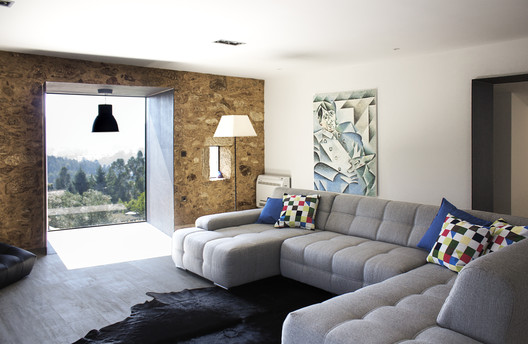 © Soraia Oliveira © Soraia Oliveira  Axonometric Axonometric 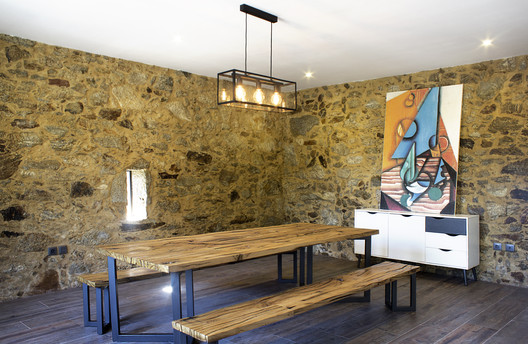 © Soraia Oliveira © Soraia Oliveira The second programming block is evident when climbing the ramp and we find the housekeeper home adorned with an old panniers and the green vineyards that reminds us the proximity to the mountains and nature. 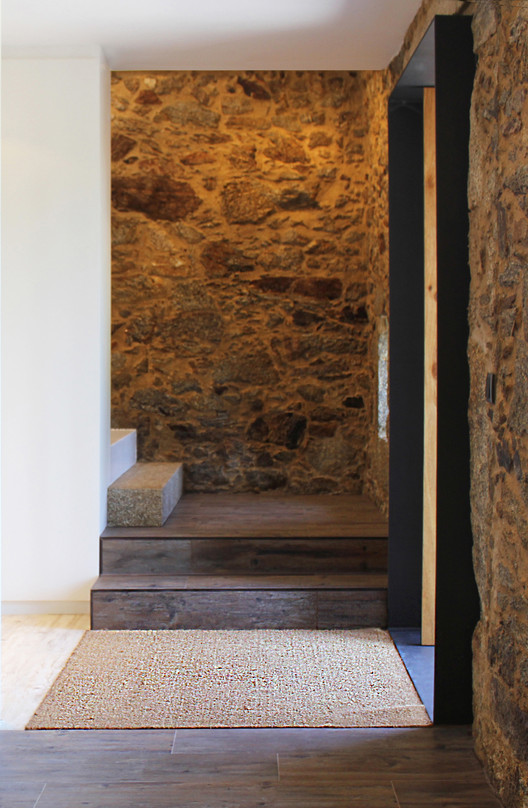 © Soraia Oliveira © Soraia Oliveira This is the main intervention and most striking building , where we find the most private and intimate spaces. With dining room and kitchen, these are divides by an element that allows the visual permeability. The kitchen cupboard is the guard for the staircase that lead us to the second floor and also the support cupboard for the living room, is a continuous and connecting element between the spaces that gives it continuity and uniformity. The living room contains one of the elements added to the building, that most mark its shape, a reading area, which leaves the building and embraces nature. Then we found a room and a more private toilet. This upper floor has a direct access to the back garden of the building that has a higher elevation.  © Soraia Oliveira © Soraia Oliveira This posting includes an audio/video/photo media file: Download Now |
| URV University Campus / Josep Ferrando + Pere Joan Ravetllat + Carme Ribas Posted: 30 Jul 2017 05:30 PM PDT  © Pedro Pegenaute © Pedro Pegenaute
 © Pedro Pegenaute © Pedro Pegenaute Situation The new building of the "Terres del l'Ebre" Campus is located in the area of the Tortosa Fairground, to the north of the city, situated between the Ebro river and the district of Remolins  Implantation Implantation Location The location is especially attractive because of its complexity. It is a representative and clearly identifiable ground as an urban framework. Halfway between the park and the city, the proposal aims to smooth the transition between the natural and urban surroundings. On the one hand, we can discover the new building in the middle of the trees, as a fragmented and discontinuous piece to allow easy integration with the surroundings of the park. From the other side, on the contrary, it is able to offer a more compact urban facade that overlies the urban topography assuming the usual height of the city.  Mock-Up Mock-Up Its settlement platform is at an upper limit of the park due to the risk of flooding. The difference of dimensions between the park and the building is solved through a series of ramps that give continuity to the space of the park.  © Pedro Pegenaute © Pedro Pegenaute The Building In plan, the building moves away from the street to obtain the necessary perimeter for the layout of the program and at the same time can be easily traversed. Contrarily, what would represent a barrier-building, the layout facilitates the diagonal routes and allows to relate the park wiith the avenue that connects the city and the fairground. The new campus wants to be the door of the park creating a beginning and an end and, ate the sime time, be the antechamber of the mentioned avenue. This duality of location characterizes its implantation.  Floor Plan Floor Plan The program The plan form allows you to set a good layout of the requested program. External galleries are established grouping by thematic areas, reducing the interior circulation, minimizing the corridors and generating squares or small relation spaces. Between these common spaces and those of specific uses located in the facade these is an element of variable thickness that serves as transition and filter. Contains support spaces such as bathrooms, facilities patios, box office, etc... promoting acoustic absorption.  © Pedro Pegenaute © Pedro Pegenaute The section aims to bring natural light to the center of the building in those strategic spaces as the end of the circulation spaces. In addition, it allows to locate the most public or open program on the ground floor where the hall is located with the exhibition space, the library connected with the computer spaces, the study room and the bar. In the first floor there are three types of classroom that houses the teaching needs, while in the second floor are located the teacher's room. Finally, the third floor houses the management room along with the university extension spaces.  Axonometrics Axonometrics The Structure The project comtemplates the construction of a building that presents the shape of a star when seen in the floor plan, with a central body practically square, where the dilatation joint is located. Around the central body are arranged five aisle with independent structures.  © Pedro Pegenaute © Pedro Pegenaute In the perimetal zones a unidirectional lining solution was planned with post-tensioned ribs supported on flat beams.  Planta en Vista Ojo de Pez Planta en Vista Ojo de Pez In the central zone, basically destined the distribution and vertical communication between common areas, lights are positioned between the pillars of 9,60m in two directions. Through this illumination, a reticular lining was planned.  © Pedro Pegenaute © Pedro Pegenaute The Surroundings Outwardly it was through a modular concrete coating that guarantees the continuity of the facade. The two types of pieces with dimensions 1.20 x 4.20m are differentiated: an opaque panel and a trellised panel that sifts the light. According to the needs of the interior spaces we can find the opaque piece, the piece of trellis or neither, so that we can discover the different views regarding the park and the city.  Section Details Section Details In the area of the ground access porch, a coating is placed on the ceramic seal of galvanized steel plates, on support system also made with galvanized steel profiles.  © Pedro Pegenaute © Pedro Pegenaute This posting includes an audio/video/photo media file: Download Now |
| Experience Architecture from Around the World with Architectural Adventures Posted: 30 Jul 2017 05:00 PM PDT  Courtesy of the AIA Courtesy of the AIA Architectural Adventures, a travel program from the American Institute of Architects (AIA), is the premier travel provider for architecture, art, and photography enthusiasts, as well as intellectually curious travelers. The program offers a variety of small-group tours specializing in the exploration and appreciation of some of the world's most remarkable architecture, all while enjoying a destination's culture, food, and traditions. Every Architectural Adventures tour features subject-matter experts, hand-picked by the AIA, to guide travelers and enliven their awareness of the world's architecture. These guides offer an up-close view of not just the iconic landmarks and buildings in the various cities, but also an explanation of how the historical, political and cultural events helped shape the cityscapes. Architectural Adventures Tour Features:
Architectural Adventures is excited to announce that some 2018 tours are now open for booking including a tour of the Bauhaus on the eve of its 100th anniversary, a trip to see some of the most creative contemporary architecture in Miami, and two cruises, one taking in the Rhine River and another traveling from Lisbon to London. In addition, this year's New Orleans tour still has available spots. Miami Perez-Art-Museum | Miami Perez-Art-Museum | Miami As the first 2018 Architectural Adventures tour, "Miami – Architectural Jewels under Tropical Skies," features a walking tour through the vibrant streets of the famed Art Deco District of South Beach, and a closer look at some of the most creative contemporary architecture in Miami in the Design District, all while learning about South Florida's historical heritage. Tour dates: February 5-9, 2018. Learn more. A Cruise from Lisbon to London Ciudad-de-la-Cultura | Spain Ciudad-de-la-Cultura | Spain Discover the lively cultural and architectural heritage of coastal Europe on a five-star cruise. From the cobbled streets of Portugal and the cathedrals of northern Spain to the hallowed beaches of Normandy and London's iconic Tower Bridge, a once-in-a-lifetime trip awaits travelers along Europe's stunning Atlantic shores. Tour dates: April 30–May 9, 2018. Learn more. Along the Rhine River Strasbourg-France | Rhine River Strasbourg-France | Rhine River From the famed historical towns of Breisach and Freiburg to the lively cities of Strasbourg and Amsterdam, discover remarkably timeless European architecture including the Notre Dame Cathedral, the Augustinerplatz, the museums of the Palais Rohan & St. Thomas Church, and even one of Europe's largest wine cellars. Tour dates: July 4-12, 2018. Learn more. Bauhaus and Beyond Bauhaus-Dessau | Germany Bauhaus-Dessau | Germany Experience the legendary Bauhaus on the brink of its 100th anniversary in Germany. Founded in Weimar by Walter Gropius in 1919, then relocated to Dessau in 1925 and closed in Berlin, the Bauhaus school of design only existed for 14 years, but it is arguably the world's most influential school of design, having revolutionized 20th-century art and architecture the world over. Learn about the legacy and impact of this innovative movement by viewing the original Bauhaus buildings, museums, and exhibitions. Tour dates: September 21-30, 2018. Learn more. New Orleans Crescent-Park | New-Orleans Crescent-Park | New-Orleans Spots are still open on the five-day 2017 New Orleans trip. From the famous Creole Townhouses and Cottages in the French Quarter and the spectacular homes in the Garden District to post-Katrina sustainable neighborhoods and some of the most important contemporary structures in the city, participants will experience the myriad of architectural gems of the Crescent City. Tour dates: October 22-27, 2017. Learn more. For more details on booking availabilities and new trip announcements, sign up for the Architectural Adventures mailing list. Additional 2018 tours will be announced soon. This posting includes an audio/video/photo media file: Download Now |
| Posted: 30 Jul 2017 01:00 PM PDT 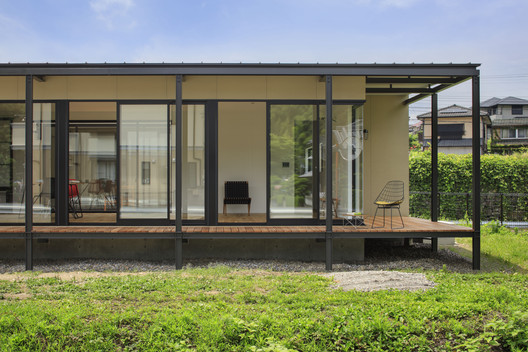 © Daisuke Shima - ad hoc inc © Daisuke Shima - ad hoc inc
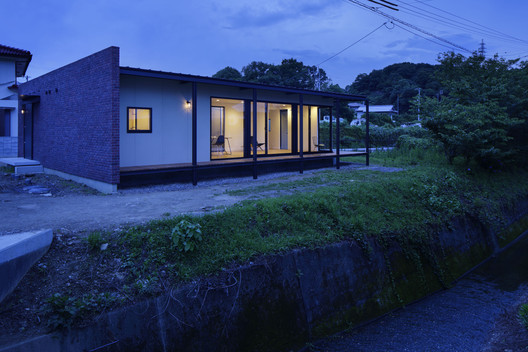 © Daisuke Shima - ad hoc inc © Daisuke Shima - ad hoc inc From the architect. The site is along the small river, crossing the bridge from the road. It is a unique site with a wild taste that distinguishes the site which is neatly divided like a housing complex. It is not summarized in white or black, and the brick and the terrace are used to harmonize with a unique site by using a rustic H-type steel, and it finished in the stately building as if it had been there for a long time.  © Daisuke Shima - ad hoc inc © Daisuke Shima - ad hoc inc The terrace along the waterway is made by floating the floor with H-type steel, and the boundary with the site is vague and the surrounding environment is taken.  © Daisuke Shima - ad hoc inc © Daisuke Shima - ad hoc inc It is a plan which opens greatly to the east with the river, and can migrate mainly in the courtyard. Enough sunlight can be secured from the morning until the day leans, and there are few losses of the movement line. In addition, in contact with the next storage, it was put out in the corridor of the West, which was originally scheduled to not set the opening for heat barrier, to eliminate the dead space of the room facing the courtyard, devised to be able to utilize the three surfaces of the wall to the fullest. 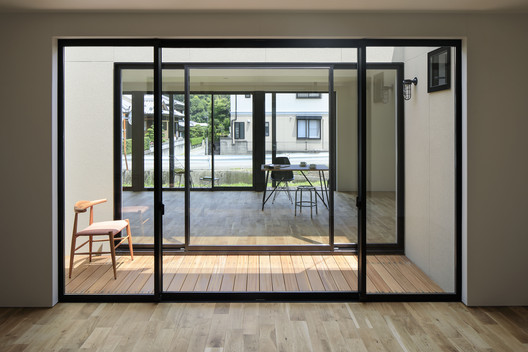 © Daisuke Shima - ad hoc inc © Daisuke Shima - ad hoc inc 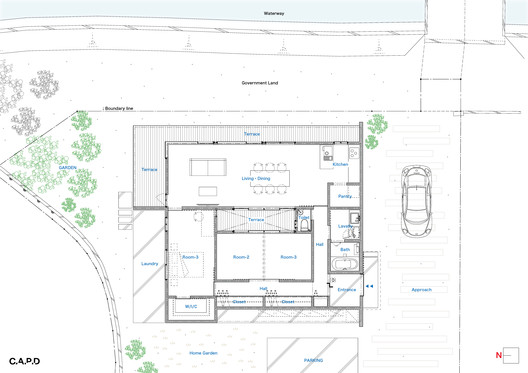 Ground Floor Plan Ground Floor Plan 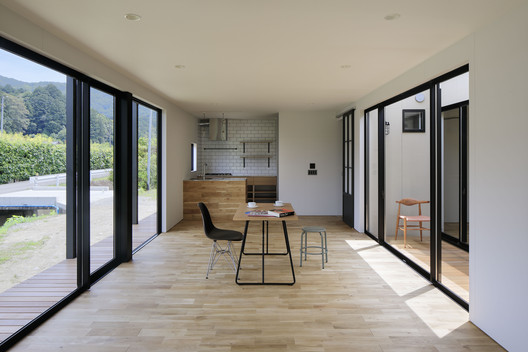 © Daisuke Shima - ad hoc inc © Daisuke Shima - ad hoc inc This posting includes an audio/video/photo media file: Download Now |
| A Tour Through the Many Doorways of India Posted: 30 Jul 2017 09:00 AM PDT 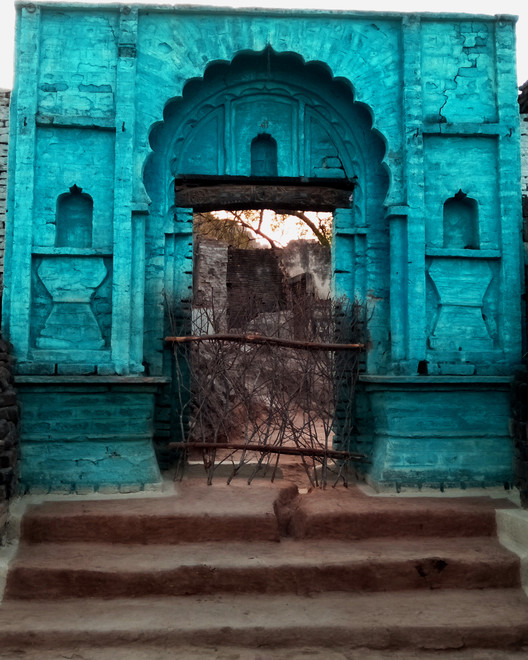 Pahara Village in Uttar Pradesh. Image © Priyanshi Singhal Pahara Village in Uttar Pradesh. Image © Priyanshi Singhal The door: despite being one of the most fundamental architectural elements, the immense significance these portals hold in architecture and culture can hardly be questioned. Historically, empires erected gigantic gateways to welcome visitors and religious shrines installed doors with ornate embellishments to ward off evil just as contemporary governments have built arches to commemorate important events. In this photo-series, however, architect Priyanshi Singhal directs her focus to doors in a humbler vein—those of homes and hole-in-the-wall shops. Armed with her camera, she travels through narrow winding streets in age-old Indian towns and villages—characterized by their mixed land-use—as she studies and documents the inherent relationship between architectural tradition, culture, and a people. A door and its chaukhat (threshold) hold deep spiritual meaning in India's traditional vastu shastra system of architecture. Furthermore, Singhal's work provides us a brief glimpse of the imprint that the vagaries of time, community and economy have left on India's historical urban fabric.  Gokul, Mathura. Image © Priyanshi Singhal Gokul, Mathura. Image © Priyanshi Singhal  Pushkar. Image © Priyanshi Singhal Pushkar. Image © Priyanshi Singhal  Old Bhopal. Image © Priyanshi Singhal Old Bhopal. Image © Priyanshi Singhal  Pedhambli Village in Gujarat. Image © Priyanshi Singhal Pedhambli Village in Gujarat. Image © Priyanshi Singhal  Mathura. Image © Priyanshi Singhal Mathura. Image © Priyanshi Singhal  Kolkata. Image © Priyanshi Singhal Kolkata. Image © Priyanshi Singhal  Gokul, Mathura. Image © Priyanshi Singhal Gokul, Mathura. Image © Priyanshi Singhal  Kolkata. Image © Priyanshi Singhal Kolkata. Image © Priyanshi Singhal  Ahmedabad. Image © Priyanshi Singhal Ahmedabad. Image © Priyanshi Singhal  Pedhambli Village in Gujarat. Image © Priyanshi Singhal Pedhambli Village in Gujarat. Image © Priyanshi Singhal  Gokul, Mathura. Image © Priyanshi Singhal Gokul, Mathura. Image © Priyanshi Singhal  Ahmedabad. Image © Priyanshi Singhal Ahmedabad. Image © Priyanshi Singhal  Mathura. Image © Priyanshi Singhal Mathura. Image © Priyanshi Singhal  Pushkar. Image © Priyanshi Singhal Pushkar. Image © Priyanshi Singhal  Kolkata. Image © Priyanshi Singhal Kolkata. Image © Priyanshi Singhal  Pushkar. Image © Priyanshi Singhal Pushkar. Image © Priyanshi Singhal  Kolkata. Image © Priyanshi Singhal Kolkata. Image © Priyanshi Singhal  Pedhambli Village in Gujarat. Image © Priyanshi Singhal Pedhambli Village in Gujarat. Image © Priyanshi Singhal  Mathura. Image © Priyanshi Singhal Mathura. Image © Priyanshi Singhal  Pushkar. Image © Priyanshi Singhal Pushkar. Image © Priyanshi Singhal  Pushkar. Image © Priyanshi Singhal Pushkar. Image © Priyanshi Singhal  Old Bhopal. Image © Priyanshi Singhal Old Bhopal. Image © Priyanshi Singhal  Pedhambli Village in Gujarat. Image © Priyanshi Singhal Pedhambli Village in Gujarat. Image © Priyanshi Singhal  Pedhambli Village in Gujarat. Image © Priyanshi Singhal Pedhambli Village in Gujarat. Image © Priyanshi Singhal  Pushkar. Image © Priyanshi Singhal Pushkar. Image © Priyanshi Singhal  Pushkar. Image © Priyanshi Singhal Pushkar. Image © Priyanshi Singhal  Pahara Village in Uttar Pradesh. Image © Priyanshi Singhal Pahara Village in Uttar Pradesh. Image © Priyanshi Singhal  Kolkata. Image © Priyanshi Singhal Kolkata. Image © Priyanshi Singhal  Ahmedabad. Image © Priyanshi Singhal Ahmedabad. Image © Priyanshi Singhal  Pushkar. Image © Priyanshi Singhal Pushkar. Image © Priyanshi Singhal  Pushkar. Image © Priyanshi Singhal Pushkar. Image © Priyanshi Singhal  Pushkar. Image © Priyanshi Singhal Pushkar. Image © Priyanshi Singhal  Pushkar. Image © Priyanshi Singhal Pushkar. Image © Priyanshi Singhal This posting includes an audio/video/photo media file: Download Now |
| Mexican Cultural Heritage and New Technology Come Together in Interactive Chair Posted: 30 Jul 2017 07:00 AM PDT The most recent Project by Okubo Studio is the Fulgar Chair, mixing traditional Mexican design with interactive technology and design to create a new piece of furniture with lights and personality. The Acapulco chair is emblematic of Mexican culture, which radically transforms not just its materials but its utility and environment.
The project arose from a desire to explore the ways in which artisan craftsmanship and tradition can hold a place in contemporary design. After 2 years of research, the designers decided to work with Mexican craftspeople to mix the cultural heritage with newer technology, coming up with a re-interpretation of the Acapulco chair. The result was an interactive chair that reacts when you get close to and sit in it.  Courtesy of Okubo Studio Courtesy of Okubo Studio In seeking to develop a chair that responds to the person using it, its features look to establish a connection between the user and the chair. Additionally, the lights within the chair mean that it transforms into an illuminating object for the surrounding space. Its interactivity is achieved through sensors which are activated by nearby movement and sound. The chairs are woven by craftspeople and then finished in a Swiss laboratory for quality and verification of the technology. The project has been well received in Zurich, Switzerland and the in Silicon Valley in the USA. This posting includes an audio/video/photo media file: Download Now |
| Mauito and Pato's Residence / Mauricio Gallegos Arquitectos Posted: 30 Jul 2017 06:00 AM PDT  © Eduardo Calvo Santisbón © Eduardo Calvo Santisbón
 © Eduardo Calvo Santisbón © Eduardo Calvo Santisbón From the architect. Located in the north of the Merida city, in the Yucatan Peninsula. In an area of generous dimensions, with an approximate surface of 1000 m², this residnce was designed for a young family, where the architectural program concentrates in a volume that always tries to relate all the spaces and inhabitants with the outside.  © Eduardo Calvo Santisbón © Eduardo Calvo Santisbón  Diagram Diagram  © Eduardo Calvo Santisbón © Eduardo Calvo Santisbón The location of the architectural object in the place responds to the presence of a dirt road bounded by a stone wall that connects with the rest of the houses and the 3 large trees of the region: Manjack (Cordia dodecandra), Kapok (Ceiba Pentandra) and a Fishfuddle (Piscidia piscipula). These trees motivated the layout of spaces and activities. A compositional axis starts from the Manjack and in it the principal access is established, dividing the house into social and private area. Another compositional axis is a circulation-gallery that runs through and connects the residence longitudinally, always relating the interior to the exterior. The intersection of these axes results in four areas: services, public, social and private.  Floor Plan Floor Plan Along the circulation-gallery are laterally positioned the service blocks. The resulting space between these is where the living areas are located. A large cover protects the inner life of the residence and, in turn, relates to the domesticated exterior landscape, indoors in constant relationship with the sun's movement and the path of our prevailing winds from the sea. So the residence opens to the east and closes to the west, without giving up the view of the sky and the treetops.  © Eduardo Calvo Santisbón © Eduardo Calvo Santisbón A clear, strong and forceful geometry, without spaces and moments for exaggerated or misunderstood architectural gestures, a residence that intends to be read and understood by its inhabitants and visitors at first sight and, in the course of it, generate spaces and surprises that relate it to the experience with the landscape and be a lesson in the importance of using outer space.  © Eduardo Calvo Santisbón © Eduardo Calvo Santisbón Three materials were used: concrete floors with aggregate of the region, block walls with chukum finish, technique inherited from our Maya ancestors and slabs with joists and stucco finish, perceiving the white color in horizontal elements and chukum in vertical ones.  © Eduardo Calvo Santisbón © Eduardo Calvo Santisbón  Diagram Diagram  © Eduardo Calvo Santisbón © Eduardo Calvo Santisbón The use of a rigorous design module facilitates the planning and execution of the work, using more efficient materials and construction methods.  © Eduardo Calvo Santisbón © Eduardo Calvo Santisbón We believe that the virtue of the project is the respect for the ground, undestanding its conditions - sun, wind - how it is located on the ground and how it uses the site, always aware of the preexistences and their role in the context. All the spaces are oriented to an intimate and human landscape garden, in dimensions and scale, experiencing the living abroad from the interior and the importance of this concept in inhabiting the Yucatan Peninsula.  © Eduardo Calvo Santisbón © Eduardo Calvo Santisbón This posting includes an audio/video/photo media file: Download Now |
| Architecture, Fashion and Performance: Photos of the Week Posted: 30 Jul 2017 05:00 AM PDT
The purpose of architectural photography is to show a design in the best possible way, with the artform often characterized by perspective correction and atmospheric lighting. However, few architectural photographers have experimented with other artistic disciplines. Miguel de Guzmán, Paul Vu and Jules Couartou are among those who have challenged the limits of this form of photography, generating an interesting crossover between architecture photography, fashion and performances. In their images, the relationship between space and the user is shown through a scene designed to register an effect on the viewer. The results are images which are full of creativity. Pilar Castro EvensenExploration between architecture, body and clothing © Pilar Castro Evensen © Pilar Castro Evensen David BoureauThe Barn / ZIEGLER Antonin architecte © David Boureau © David Boureau Jules CouartouViking Seaside Summer House / FREAKS Architecture © Jules Couartou © Jules Couartou Paul VuELL / Domaen © Paul Vu © Paul Vu Imagen SubliminalSplash / Manuel Ocaña © Imagen Subliminal © Imagen Subliminal Miguel de GuzmánEspinar House / Miguel de Guzmán + Veidimanna Protum © Miguel de Guzmán © Miguel de Guzmán Gartnerfuglen & Mariana de DelásGrooming Retreat / Gartnerfuglen + Mariana de Delás Courtesy of Gartnerfuglen & Mariana de Delás Courtesy of Gartnerfuglen & Mariana de Delás Omar Van de WyngardExploration between architecture, body and clothing © Omar Van de Wyngard © Omar Van de Wyngard Neave BozorgiIN.DENT / AN.ONYMOUS © Neave Bozorgi © Neave Bozorgi Koji Fujii - Nacasa & Partners IncRibbon Chapel / Hiroshi Nakamura & NAP Architects © Koji Fuji - Nacasa & Partners Inc © Koji Fuji - Nacasa & Partners Inc Alberto KalachBiblioteca Jose Vasconcelos / Alberto Kalach Courtesy of Alberto Kalach Courtesy of Alberto Kalach Karli LuikFast Track / Salto AB 2 Courtesy of Karli Luik Courtesy of Karli Luik Fernando Guerra | FG+SGCasa Cabo de Vila / spaceworkers © Fernando Guerra | FG+SG © Fernando Guerra | FG+SG Paul VuELL / Domaen © Paul Vu © Paul Vu Jorge López CondeCAAC / Paredes Pino © Jorge López Conde © Jorge López Conde Cornbread WorksDrents Archive / Zecc Architecten © Cornbread Works © Cornbread Works This posting includes an audio/video/photo media file: Download Now |
| Remember Me? 15 Buildings Your Professors Loved To Talk About Posted: 30 Jul 2017 02:30 AM PDT  You're a chipper young first-year student, still soft and tender in the early stages of your induction into the cult of architecture. Apart from fiddling with drafting triangles and furiously scribbling down the newfound jargon that is going to forever change how you communicate, you often find yourself planted in a seat, eyes transfixed to a projector screen as your professor-slash-cult-leader flashes images of the architecture world's masterpieces, patron saints, and divine structures. Soon, you develop a Pavlovian response: you instinctively recognize these buildings, can name them at once and recite a number of soundbites about their design that have lodged themselves in your brain. Your professor looks on in approval. Since we here at ArchDaily have also partaken in this rite of passage, here are 15 buildings that we all recognize from the rituals of architecture school. Acropolis of Athens / Ictinus, Callicrates, Mnesikles & Phidas © <a href='https://www.flickr.com/photos/kudumomo/15452894059'>Flickr user kudumomo</a> licensed under <a href='https://creativecommons.org/licenses/by/2.0/'>CC BY 2.0</a> © <a href='https://www.flickr.com/photos/kudumomo/15452894059'>Flickr user kudumomo</a> licensed under <a href='https://creativecommons.org/licenses/by/2.0/'>CC BY 2.0</a> Roman Pantheon / Emperor Hadrian © <a href='https://www.flickr.com/photos/timmccune/1336587594'>Flickr user timmccune</a> licensed under <a href='https://creativecommons.org/licenses/by/2.0/'>CC BY 2.0</a> © <a href='https://www.flickr.com/photos/timmccune/1336587594'>Flickr user timmccune</a> licensed under <a href='https://creativecommons.org/licenses/by/2.0/'>CC BY 2.0</a> Cenotaph for Newton / Etienne-Louis Bouillée Image in public domain Image in public domain The Crystal Palace / Joseph Paxton Image <a href='https://upload.wikimedia.org/wikipedia/commons/archive/d/d8/20130712160707%21Crystal_Palace_General_view_from_Water_Temple.jpg'>via Wikimedia</a>. Photo by Philip Henry Delamotte in public domain Image <a href='https://upload.wikimedia.org/wikipedia/commons/archive/d/d8/20130712160707%21Crystal_Palace_General_view_from_Water_Temple.jpg'>via Wikimedia</a>. Photo by Philip Henry Delamotte in public domain Fagus Factory / Walter Gropius & Adolf Meyer © Carsten Janssen <a href='https://commons.wikimedia.org/wiki/File:Fagus_Gropius_Hauptgebaeude_200705_wiki_front.jpg'>via Wikimedia</a> licensed under <a href='https://creativecommons.org/licenses/by-sa/2.0/de/deed.en'>CC BY-SA 2.0 DE</a> © Carsten Janssen <a href='https://commons.wikimedia.org/wiki/File:Fagus_Gropius_Hauptgebaeude_200705_wiki_front.jpg'>via Wikimedia</a> licensed under <a href='https://creativecommons.org/licenses/by-sa/2.0/de/deed.en'>CC BY-SA 2.0 DE</a> Villa Savoye / Le Corbusier © <a href='https://www.flickr.com/photos/augustfischer/23478735942'>Flickr user augustfischer</a> licensed under <a href='https://creativecommons.org/licenses/by-nd/2.0/'>CC BY-ND 2.0</a> © <a href='https://www.flickr.com/photos/augustfischer/23478735942'>Flickr user augustfischer</a> licensed under <a href='https://creativecommons.org/licenses/by-nd/2.0/'>CC BY-ND 2.0</a> Barcelona Pavilion / Mies van der Rohe © Gili Merin © Gili Merin Villa Malaparte / Adalberto Libera © <a href='https://www.flickr.com/photos/frans16611/4729750386'>Flickr user frans16611</a> licensed under <a href='https://creativecommons.org/licenses/by/2.0/'>CC BY 2.0</a> © <a href='https://www.flickr.com/photos/frans16611/4729750386'>Flickr user frans16611</a> licensed under <a href='https://creativecommons.org/licenses/by/2.0/'>CC BY 2.0</a> Maison de Verre / Pierre Chareau & Bernard Bijvoet © <a href='https://www.flickr.com/photos/augustfischer/32468043091'>Flickr user augustfischer</a> licensed under <a href='https://creativecommons.org/licenses/by-nd/2.0/'>CC BY-ND 2.0</a> © <a href='https://www.flickr.com/photos/augustfischer/32468043091'>Flickr user augustfischer</a> licensed under <a href='https://creativecommons.org/licenses/by-nd/2.0/'>CC BY-ND 2.0</a> Seagram Building / Mies van der Rohe Image <a href='https://commons.wikimedia.org/wiki/File:NewYorkSeagram_04.30.2008.JPG'>via Wikimedia</a>. Image by Wikimedia user Noroton in public domain Image <a href='https://commons.wikimedia.org/wiki/File:NewYorkSeagram_04.30.2008.JPG'>via Wikimedia</a>. Image by Wikimedia user Noroton in public domain Habitat 67 / Moshe Safdie © Canadian Architecture Collection, McGill © Canadian Architecture Collection, McGill Munich Olympic Stadium / Frei Otto & Gunther Behnisch © <a href='https://www.flickr.com/photos/74862615@N00/262471207'>Flickr user emdees</a> licensed under <a href='https://creativecommons.org/licenses/by/2.0/'>CC BY 2.0</a> © <a href='https://www.flickr.com/photos/74862615@N00/262471207'>Flickr user emdees</a> licensed under <a href='https://creativecommons.org/licenses/by/2.0/'>CC BY 2.0</a> Therme Vals / Peter Zumthor © Fernando Guerra | FG+SG © Fernando Guerra | FG+SG Seattle Central Library / OMA + LMN © Philippe Ruault © Philippe Ruault House N / Sou Fujimoto © Iwan Baan © Iwan Baan How will this list of classics fare in future generations? Time will tell! This posting includes an audio/video/photo media file: Download Now |
| Luciana Brito's Gallery / Piratininga Arquitetos Associados Posted: 30 Jul 2017 02:00 AM PDT  © André Scarpa © André Scarpa
 © Romulo Fialdini © Romulo Fialdini From the architect. According to the book RINO LEVI Architecture and City, Romano Guerra publisher, p.254: "Fourth project of the series of introspective houses, this residence develops the architectural design approach adopted in the church and chapel of São José dos Campos: a unique space, built of two side stripes with open gardens and a covered and protected central strip. The central space is the living and dining room, which extends through the side gardens protected by pergolas. The delimitation of this unique space is provided by the structure of the house: in the back, the bedrooms; on the right side, the kitchen, pantry and breakfast room; on the left side, the vestibule with toilet, acess to the underground cellar and a small room; in the front, the services and the garage, with the peculiar situation of the housekeeper dormitories, a white volume, raised and blinded for the street."  © Romulo Fialdini © Romulo Fialdini  Ground Floor Plan Ground Floor Plan  © Romulo Fialdini © Romulo Fialdini For Ana Elísia da Costa, professor and researcher at the Faculty of Architecture of Federal University of Rio Grande do Sul, in her PhD thesis titled O Gosto por Sutil. Confluence between the Patio Houses of Daniele Calabi and Rino Levi: "The house occupies a narrow and long half-block batch. From the front setback, three volumes are arranged: in the front part of the lot, a small block on slender columns, that shelters the garage and the housekeeper dependencies; to the center, a large rectangular prism, with small lateral setback, that organizes the main structure of the house; and, in the back part of the lot, a shed, which absorbs the geometrical irregularity of the ground and accomodates guest rooms and party room. The resulting volumetry of the set is pure and gains expression through the contraposition between the horizontality of the main prism and the verticality of the volume on slender columns.  © Romulo Fialdini © Romulo Fialdini  Section Section  © Romulo Fialdini © Romulo Fialdini The main prism is torn by a large central courtyard, which, as a compositional center, organizes the zoning of the house on three sides - service sector in the right side, with independent access through the garage; access and main circulation in the left side; private sector at the back of the lot, ensuring privacy to the bedrooms and favorable solar orientation (northwest). The peripheral occupation of the volume stem from the central void, as is classic in this typological scheme, is transgressed with the disposition of the aisle of the social sector, which in an unusual way "invades" the great patio."  © André Scarpa © André Scarpa Much of the original executive project, designed by the architect Rino Levi and his team, is in the part of the conservation acquis of the library of FAU USP, without access to the general public. The material available and to which we had access are copies of some drawings of the city hall approval project, executive plans and some details.  Sketch Sketch Some of these drawings were presented of great importance for understanding the construction and above all, the spirit and architectural design approach of the residence.  © André Scarpa © André Scarpa The gardens and landscaping, in general, are just as important as the construction itself, setting in this rhythm of the occupied and empty areas, or building and gardens. In the research of the drawings, original drawings of the gardens were found. Below we copy the plan with the landscaping design and the construction of these voids, found in the collections of FAU USP. For the intervention the landscape designers Klara Kaiser and Koiti Mori who worked in the office of Roberto Burle Marx were hired, they were who made the investigation of its authorship. Here is the opinion of the landscapers about the gardens of the residence: "The knowledge of professional intense interaction and the testimony of a wide range of works carried out in partnership between Rino Levi and Burle Marx makes plausible the assumption that the garden is from the landscaper and artist. And there are, in fact, some concrete indications in their favor, such as the presence of some perennial and / or larger species of plants in the gardens that Burle Marx appreciated and used in similar contexts: there are some groupings or associations familiar to their language.  © André Scarpa © André Scarpa However, the plan found in the collections does not appear to be from the artist's office. Testify against it, first of all, the formal solutions of some areas, the organization of the plants list, the forms of identification of the species, and even the spelling of several species.  © André Scarpa © André Scarpa In face of what was found, our preliminary understanding is that without prejudice to furthers research about the authorship original project of the garden, the task is to understand the new building program, based essentially on the guidelines emanating from the Rino Levi's self Project. In essence, make the project emphasize, as the essential feature of the architectural design approach, the alternation between the built spaces and the garden areas, creating at the same time a zoning of uses, a peculiar rhythm of apprehension of space and last but not least, the creation of specific environments for each place of use."
This posting includes an audio/video/photo media file: Download Now |
| This Smart Glass Can Change From Opaque to Transparent in Just Seconds Posted: 30 Jul 2017 01:00 AM PDT
A relative newcomer to the material world, smart glass (also known as switch glass or electrochromic glass) has the ability to change its properties and appearance, allowing the environmental conditions of a space to be optimized according to the use and needs of its users. Electrochromic glass technology works by changing the electrical polarization between some of its components. Its most widely used variant, known as PDCL, consists of a thin film of liquid crystal that sits between two conductive transparent plastic layers (usually laminated glass). By changing the current running through the liquid crystal, the glass can take on different appearences. When de-energized, liquid crystals are in a disordered, misaligned state that fractures incoming light, delivering an opaque white tone. When energized with a voltage between 24 and 100 volts, the crystals are arranged to allow light to pass through relatively unimpeded, delivering a transparency of between 55% and 85%. This innovation is currently available in a large number of colors, and the stability to the ultra violet rays, which was one of the problems of the first generation of these glasses, is practically solved. This posting includes an audio/video/photo media file: Download Now |
| The Peckham Observatory / Cooke Fawcett Posted: 29 Jul 2017 10:00 PM PDT  © Peter Landers Photography © Peter Landers Photography
 © Peter Landers Photography © Peter Landers Photography From the architect. For Bold Tendencies, their 3.5m-wide raised platform spans the entire width of the car park, its steel support beams cantilevered at both ends. Two staircases at either side provide an elevated promenade and on the northern tip the balustrade position at the half-landing provides unencumbered views of London.  © Peter Landers Photography © Peter Landers Photography The deck and steps are made of full-width hardwood timber decking, and three areas of custom-designed benches and sun-loungers are planned. Timber handrails on the upper level are angled to provide natural places to lean and rest, taking in the artwork and activities taking place on the roof of the car park, with Frank's Bar at the far end. Nestled underneath the steelwork is a timber-framed box painted dark blue. This kiosk will provide Bold Tendencies with much-needed space for staff, serving as an information point, ticket booth and shop. It will also act as a hub for the Bold Everywhere educational programme.  Perspective 02 Perspective 02  Perspective 01 Perspective 01 The new structure has been achieved on a very low budget as Bold Tendencies took on the project management themselves and worked with local suppliers and contractors, making this a thoroughly Peckham endeavour from start to finish. This is Cooke Fawcett's second commission for Bold Tendencies. Their previous project, Concert Wall, is a concertinaed plywood screen which provides an acoustic and visual backdrop for live music performances.  © Peter Landers Photography © Peter Landers Photography Oliver Cooke, director of Cooke Fawcett, said: "We're so pleased to return to Bold Tendencies with another project that enhances the experience of the car park and the art contained within it."  © Peter Landers Photography © Peter Landers Photography Francis Fawcett added: "For an avant garde cultural institution now in its 11th year, it is important that Bold Tendencies retains the capacity to reinvent and present new experiences to its loyal following as well as to new visitors."  © Peter Landers Photography © Peter Landers Photography  Plan Plan  © Peter Landers Photography © Peter Landers Photography This posting includes an audio/video/photo media file: Download Now |
| You are subscribed to email updates from ArchDaily. To stop receiving these emails, you may unsubscribe now. | Email delivery powered by Google |
| Google Inc., 1600 Amphitheatre Parkway, Mountain View, CA 94043, United States | |




Nema komentara:
Objavi komentar